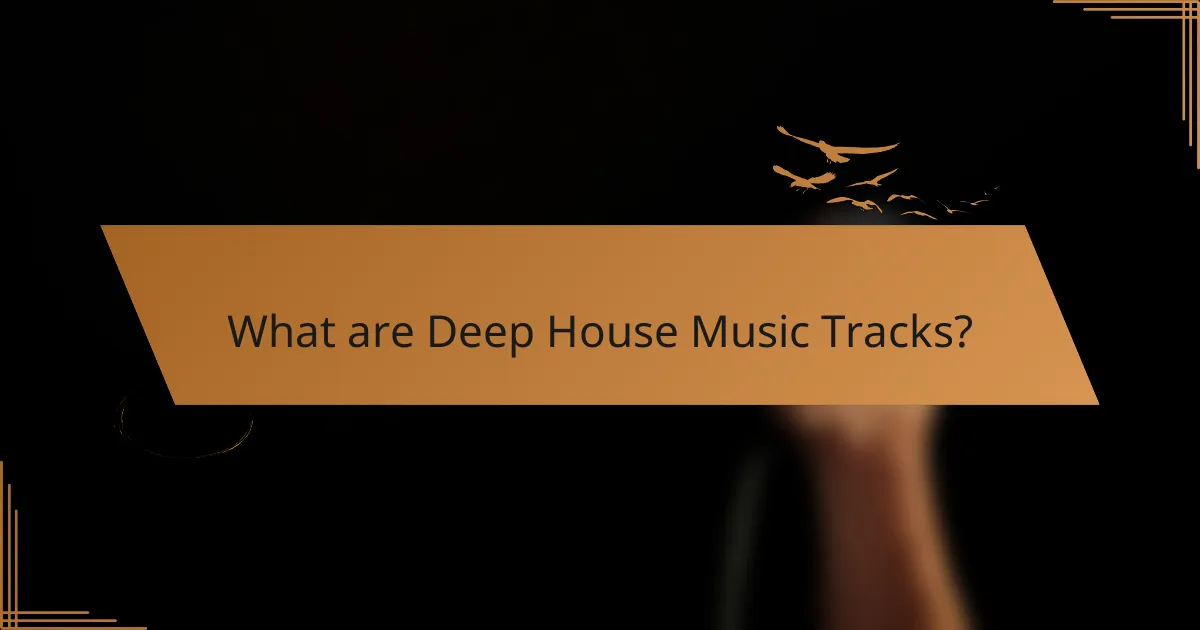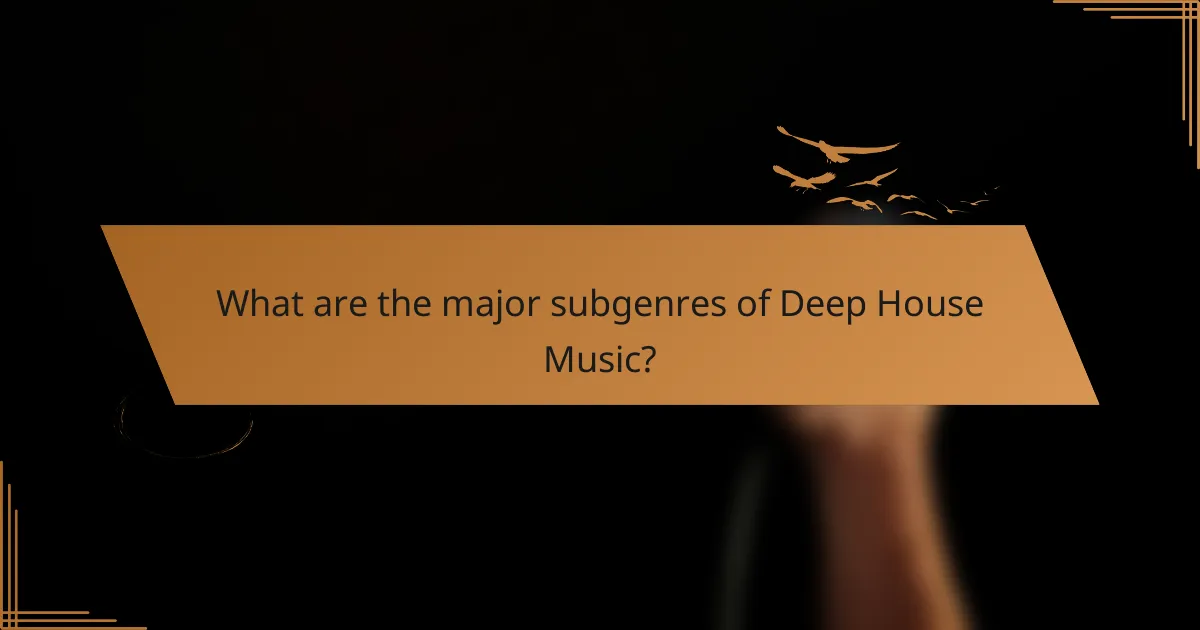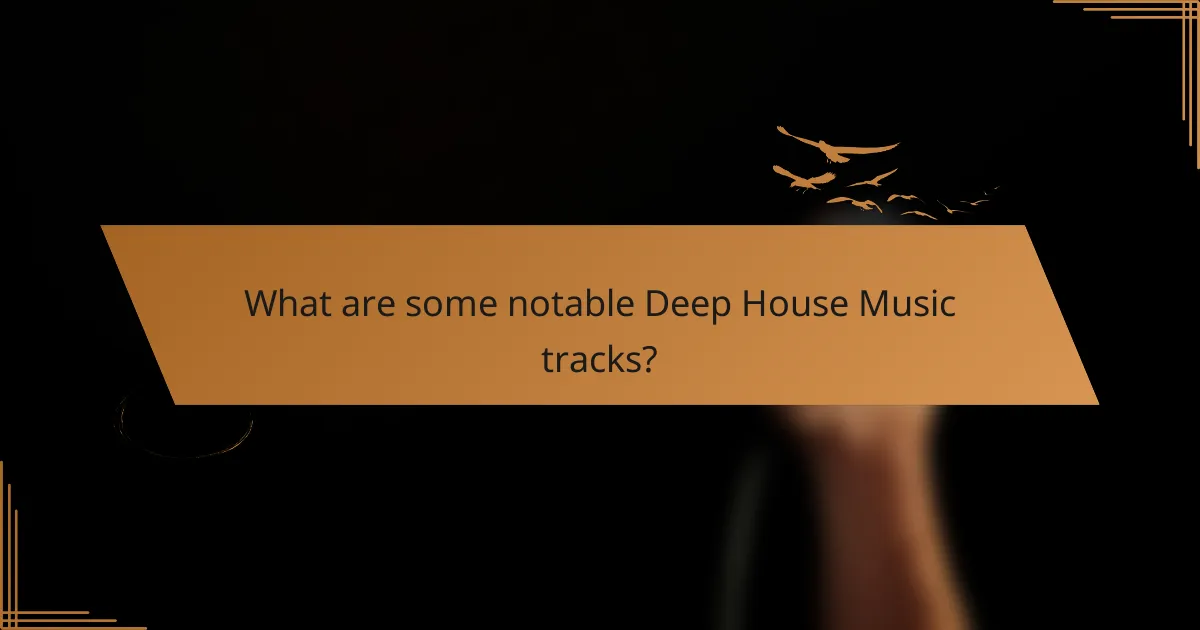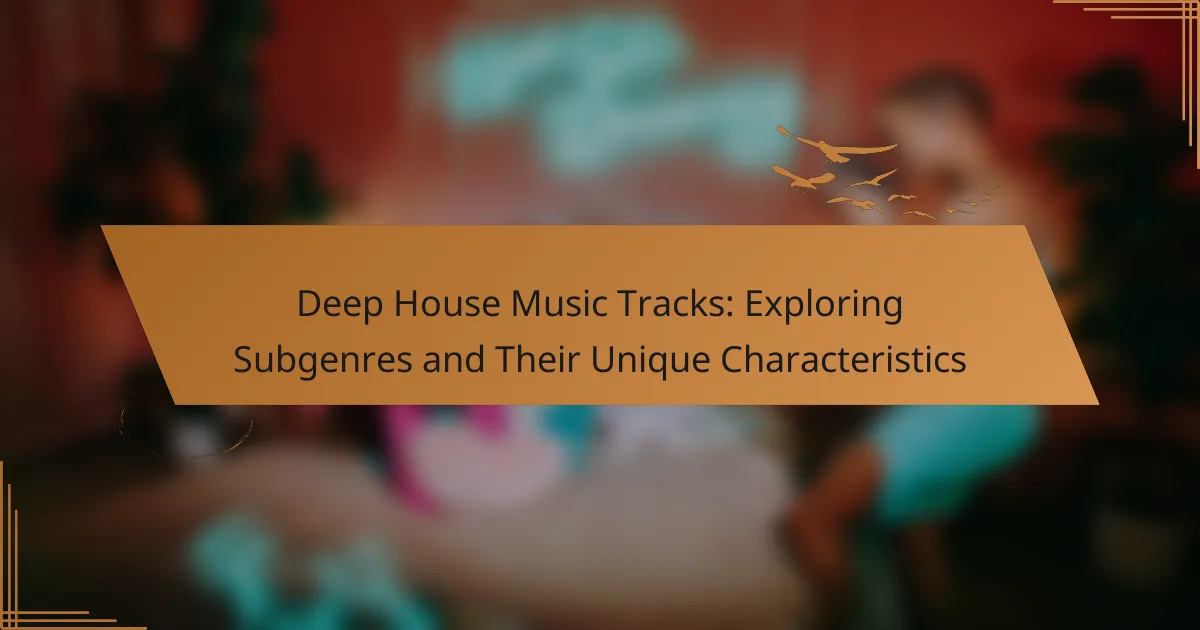Deep house music tracks represent a subgenre of house music characterized by their smooth and soulful sound, typically featuring a tempo of 120 to 125 BPM. This genre incorporates complex melodies, rich harmonies, and influences from jazz, funk, and soul, often highlighted by soft and atmospheric vocals. Deep house gained traction in the 1980s and 1990s, particularly within club and underground scenes, with notable artists like Larry Heard and Kerri Chandler shaping its development. The article will explore major subgenres such as soulful house, tech house, and jazzy house, detailing their unique characteristics and the diversity within the deep house music scene. Additionally, it will highlight significant tracks that exemplify the deep house sound, including “Can’t Get Enough” by Soulsearcher and “Finally” by Kings of Tomorrow.

What are Deep House Music Tracks?
Deep house music tracks are a subgenre of house music known for their smooth, soulful sound. They typically feature a tempo ranging from 120 to 125 BPM. Deep house tracks often incorporate complex melodies and rich harmonies. They frequently use jazz, funk, and soul influences. Vocals in deep house music are usually soft and atmospheric. This genre emphasizes a laid-back vibe, making it suitable for relaxation and social settings. Deep house gained popularity in the 1980s and 1990s, especially in clubs and underground scenes. Notable artists include Larry Heard and Kerri Chandler, who helped shape its sound.
How did Deep House Music originate?
Deep House Music originated in the 1980s in Chicago. It emerged as a subgenre of house music. Key figures like Larry Heard and Frankie Knuckles played pivotal roles in its development. The genre is characterized by its soulful vocals and complex melodies. Deep house often incorporates elements of jazz and funk. Its sound is generally slower than other house music styles. The genre gained popularity in clubs and underground scenes. By the 1990s, it began to spread internationally, influencing various music scenes.
What influences shaped the development of Deep House Music?
Deep House Music developed through a blend of various influences. It emerged in the 1980s, primarily influenced by Chicago house music. The genre incorporates elements of jazz, soul, and funk. Notable artists like Larry Heard helped shape its sound. Deep House often features smooth, melodic lines and complex chords. The use of synthesizers and drum machines also played a crucial role. Additionally, the genre is characterized by its laid-back tempo and atmospheric soundscapes. These influences collectively contributed to the distinctive style of Deep House Music.
How has Deep House Music evolved over the years?
Deep House Music has evolved significantly since its inception in the 1980s. Initially, it emerged from Chicago house music, characterized by its soulful vocals and jazz influences. In the 1990s, the genre incorporated elements from techno and ambient music, leading to a more melodic and atmospheric sound. The 2000s saw a rise in popularity due to artists like Kerri Chandler and Miguel Migs, who introduced deeper basslines and complex rhythms. The advent of digital production tools further transformed deep house, allowing for more intricate sound design. In the 2010s, the genre gained mainstream recognition, with tracks topping charts and being featured in major festivals. Today, deep house continues to evolve, blending with other genres such as pop and indie, showcasing its versatility and broad appeal.
What are the defining characteristics of Deep House Music?
Deep House Music is characterized by its smooth, soulful sound and deep basslines. It typically features slower tempos, usually ranging from 120 to 125 BPM. The genre often incorporates elements of jazz, funk, and soul. Vocals in Deep House are usually soft and melodic, enhancing its emotional depth. It frequently employs lush synth pads and atmospheric effects to create a rich soundscape. The genre is known for its emphasis on groove, making it suitable for dancing and relaxation alike. Deep House has roots in the Chicago house scene of the 1980s, evolving over time to include diverse influences. Its popularity surged in the 2010s, becoming a staple in clubs and music festivals worldwide.
What elements distinguish Deep House from other genres?
Deep House is distinguished from other genres by its smooth, complex melodies and deep basslines. It typically features a slower tempo, usually between 120 to 125 BPM. The genre often incorporates elements of jazz, soul, and funk, creating a warm and inviting sound. Vocal samples are commonly used, often featuring soulful or ethereal voices. Additionally, Deep House emphasizes atmospheric soundscapes and intricate chord progressions. Its use of subtle percussion and rhythmic elements contributes to a laid-back vibe. Unlike other electronic genres, Deep House prioritizes emotional depth and groove over high-energy beats. These characteristics collectively define its unique identity within the broader electronic music landscape.
How do tempo and rhythm play a role in Deep House tracks?
Tempo and rhythm are fundamental elements in Deep House tracks. They create the overall feel and energy of the music. Typically, Deep House features a tempo ranging from 120 to 125 BPM. This moderate tempo allows for a relaxed yet danceable vibe. The rhythm often incorporates syncopated basslines and intricate hi-hat patterns. These elements enhance the groove and maintain listener engagement. Additionally, the use of swing in rhythm adds a human touch, making the music feel more organic. The interplay between tempo and rhythm establishes the emotional depth characteristic of Deep House. This genre often aims to evoke feelings of introspection and euphoria through its rhythmic structure.
Why is Deep House Music popular in contemporary culture?
Deep House Music is popular in contemporary culture due to its unique blend of soulful melodies and electronic beats. This genre creates an immersive atmosphere that resonates with listeners. The smooth, laid-back rhythms make it appealing for both casual listening and dance environments. Deep House often features rich basslines and atmospheric synths, which enhance its emotional depth. Its roots in disco and jazz contribute to its widespread acceptance across diverse audiences. Additionally, the rise of streaming platforms has facilitated easy access to Deep House tracks. This accessibility has led to increased discovery and appreciation of the genre among younger generations. Overall, the combination of musical complexity and emotional resonance drives its popularity today.
What role do Deep House tracks play in social settings?
Deep House tracks create an uplifting atmosphere in social settings. They often feature smooth melodies and steady beats. This combination promotes relaxation and encourages social interaction. The genre’s rhythmic elements help to establish a comfortable environment. Research indicates that music influences social behavior and mood. A study published in the Journal of Consumer Research found that background music can enhance social experiences. Deep House tracks, with their immersive soundscapes, facilitate connection among listeners. They are commonly played in lounges and parties to enhance the overall experience.
How has technology impacted the production of Deep House Music?
Technology has significantly transformed the production of Deep House Music. Digital audio workstations (DAWs) have streamlined music creation. Producers can now manipulate sound with precision using software like Ableton Live and FL Studio. MIDI technology allows for easy composition and arrangement of musical elements. Virtual instruments and plugins offer a vast array of sounds and effects. This accessibility has democratized music production, enabling more artists to create. Sampling technology has expanded the creative palette by integrating diverse sounds. Additionally, online distribution platforms have changed how music reaches audiences. These advancements have reshaped the landscape of Deep House Music production.

What are the major subgenres of Deep House Music?
The major subgenres of Deep House Music include soulful house, tech house, and jazzy house. Soulful house emphasizes smooth vocals and rich harmonies. Tech house blends elements of techno and house, focusing on rhythm and minimalism. Jazzy house incorporates jazz influences, featuring live instrumentation and improvisation. Each subgenre has distinct characteristics that appeal to different audiences. These variations contribute to the overall diversity within the deep house music scene.
What defines the various subgenres within Deep House?
Various subgenres within Deep House are defined by distinct characteristics such as tempo, instrumentation, and mood. For example, Vocal Deep House features prominent vocals and a melodic structure. In contrast, Afro Deep House incorporates African rhythms and percussion. Tech Deep House leans towards a more minimalistic sound with electronic elements. Each subgenre maintains a tempo typically ranging from 120 to 125 BPM, which is a common trait of Deep House. The use of lush chords and smooth basslines is also a hallmark across these subgenres. These defining features help categorize tracks and identify the unique qualities that differentiate them within the Deep House genre.
How do Deep Tech and Soulful House differ from traditional Deep House?
Deep Tech and Soulful House differ from traditional Deep House primarily in their sound and production techniques. Deep Tech emphasizes minimalism, intricate rhythms, and a more experimental approach. It often incorporates elements from techno and focuses on the groove, creating a darker atmosphere. In contrast, Soulful House prioritizes melodic elements, rich harmonies, and emotional vocals. It draws heavily from jazz, gospel, and funk influences, resulting in a more uplifting and soulful sound. Traditional Deep House combines both elements but tends to maintain a smoother, more laid-back feel without the experimental edge of Deep Tech or the emotive depth of Soulful House.
What are the unique traits of Progressive Deep House?
Progressive Deep House is characterized by its melodic elements and atmospheric soundscapes. It typically features longer track durations, allowing for gradual build-ups and intricate transitions. The genre often incorporates lush synthesizers and deep basslines, creating a rich auditory experience. Vocals, when present, are usually ethereal and harmonically layered. The tempo generally ranges from 120 to 128 BPM, maintaining a steady groove. Progressive Deep House emphasizes emotional resonance, often evoking feelings of nostalgia or introspection. Its production techniques frequently involve complex layering and effects, enhancing the immersive quality. These traits distinguish it from other subgenres within deep house, contributing to its unique appeal.
Which artists are prominent in different Deep House subgenres?
Prominent artists in different Deep House subgenres include Disclosure, who are known for their blend of house and pop elements. Another key artist is Maya Jane Coles, recognized for her deep, atmospheric sound. In the subgenre of soulful deep house, artists like Osunlade stand out with their rich, melodic style. For tech house influences within deep house, Green Velvet is a notable figure, merging techno and house rhythms. Each of these artists exemplifies the distinct characteristics of their respective subgenres, contributing to the evolution of deep house music.
What contributions have key artists made to the evolution of subgenres?
Key artists have significantly influenced the evolution of subgenres in deep house music. Artists like Larry Heard pioneered the Chicago house sound, integrating soulful melodies and lush chords. His track “Can You Feel It” is considered foundational in establishing deep house’s emotional depth. Similarly, Kerri Chandler introduced a more percussive approach, shaping the New Jersey sound. His work emphasized groove and rhythm, influencing future subgenres. Additionally, artists like Maya Jane Coles have brought a modern twist, blending elements from various genres. Her innovative productions have expanded the boundaries of deep house, attracting diverse audiences. Overall, these contributions have shaped the distinct characteristics and evolution of deep house subgenres.
How do the styles of different artists reflect their subgenre influences?
The styles of different artists reflect their subgenre influences through distinct musical elements and production techniques. Each artist incorporates specific rhythms, melodies, and instrumentation that align with their chosen subgenre. For instance, deep house artists often utilize smooth basslines and atmospheric pads. This creates a laid-back vibe characteristic of the genre. In contrast, tech house artists may emphasize percussive elements and faster tempos, showcasing a more energetic feel.
Additionally, vocal styles can vary significantly between subgenres. Deep house may feature soulful vocals, while tech house often uses minimal or spoken-word samples. Historical context also plays a role. Artists influenced by Chicago house may integrate jazz and funk elements, whereas those influenced by Detroit techno might focus on mechanical sounds and futurism.
These stylistic choices not only define their music but also connect them to their subgenre roots. The evolution of these influences can be traced through the development of the genres themselves. For example, the shift from disco to house music in the 1980s led to the incorporation of various musical influences that artists still draw upon today.
How do subgenres influence the overall sound of Deep House Music?
Subgenres influence the overall sound of Deep House Music by introducing distinct characteristics and elements. Each subgenre, such as soulful, tech, or progressive house, adds unique rhythmic patterns and melodic structures. For instance, soulful house often features rich vocals and jazz-influenced chords. In contrast, tech house emphasizes minimalistic beats and electronic sounds. Progressive house tends to incorporate longer builds and atmospheric elements. These variations create diverse listening experiences within the deep house genre. The evolution of these subgenres reflects the genre’s adaptability and appeal across different audiences.
What impact do subgenre characteristics have on listener experience?
Subgenre characteristics significantly shape listener experience in deep house music. Each subgenre, such as soulful, tech, or ambient, brings distinct elements. These elements influence the mood, energy, and overall vibe of the tracks. For instance, soulful deep house often features rich vocals and jazzy chords, creating an emotional connection. In contrast, tech deep house emphasizes rhythmic beats and minimalistic sounds, which can energize listeners on the dance floor. The specific characteristics of a subgenre determine how listeners engage with the music. Research indicates that genre-specific traits affect emotional responses and preferences. This highlights the importance of subgenre characteristics in enhancing the listener experience.
How can understanding subgenres enhance appreciation of Deep House Music?
Understanding subgenres enhances appreciation of Deep House Music by providing insight into its diverse styles. Each subgenre, such as soulful, tech, or ambient deep house, offers unique characteristics. These variations influence rhythm, instrumentation, and mood. For example, soulful deep house emphasizes melodic elements and vocal samples. In contrast, tech deep house focuses on minimalistic beats and electronic sounds. Recognizing these distinctions allows listeners to identify their preferences. This knowledge deepens engagement with the music. Additionally, understanding subgenres can enhance live performance experiences. DJs often blend different subgenres, creating dynamic sets. This exploration fosters a richer connection to the genre as a whole.

What are some notable Deep House Music tracks?
Notable Deep House Music tracks include “Can’t Get Enough” by Soulsearcher. This track topped charts in the late 1990s. Another significant track is “Deep Inside” by Hardrive, released in 1993. It features a memorable vocal sample that became iconic in the genre. “So Get Up” by DJ Sneak is also important, known for its funky basslines. “Finally” by Kings of Tomorrow is a classic, celebrated for its soulful vocals. These tracks exemplify the deep house sound, blending elements of house with jazz and soul influences.
Which tracks are considered classics in Deep House Music?
Classic tracks in Deep House Music include “Can You Feel It” by Mr. Fingers and “Your Love” by Frankie Knuckles. These tracks are foundational to the genre. “Can You Feel It,” released in 1986, is often regarded as one of the first deep house tracks. Its atmospheric sound and emotive melodies set a standard for future productions. “Your Love,” released in 1986 as well, is celebrated for its iconic bassline and soulful vocals. Both tracks have influenced countless artists and remain staples in deep house sets today.
What elements make these tracks stand out?
Deep house music tracks stand out due to their distinctive melodic structure and rhythmic elements. They typically feature smooth, soulful vocals that enhance emotional depth. The use of jazzy chords and intricate harmonies adds complexity. Deep basslines provide a solid foundation, creating a rich sound. The tempo generally ranges from 120 to 125 BPM, promoting a relaxed vibe. Atmospheric pads and synths contribute to a lush soundscape. Tracks often incorporate samples from various genres, adding uniqueness. The overall production quality is usually polished, ensuring clarity and richness in sound.
How have these tracks influenced the genre as a whole?
These tracks have significantly shaped the deep house genre. They introduced innovative soundscapes and rhythmic structures. Artists like Larry Heard and Kerri Chandler set foundational elements. Their use of soulful melodies and intricate basslines became genre standards. Tracks from the 1990s established a template for future productions. The incorporation of jazz and funk elements broadened the genre’s appeal. This fusion attracted a diverse audience and influenced emerging artists. As a result, deep house has evolved while maintaining its core characteristics.
What are some recent Deep House tracks gaining popularity?
Recent Deep House tracks gaining popularity include “Looking for Me” by Paul Woolford, Diplo, and Kareen Lomax. Another notable track is “Deep End” by John Summit. “I Feel for You” by Tchami also continues to rise in charts. These tracks have received significant airplay and streaming activity. They showcase the evolving sound of Deep House. Their catchy melodies and rhythmic basslines resonate with audiences. These tracks highlight the genre’s blend of house and soulful elements.
How do these tracks reflect current trends in Deep House Music?
Current Deep House music tracks showcase evolving soundscapes and production techniques. They often incorporate elements from other genres like techno and ambient. The use of organic instruments alongside digital sounds is increasingly popular. Vocal samples have become more prominent, adding emotional depth to the tracks. Additionally, there is a noticeable trend towards longer, more immersive tracks that encourage listener engagement. The rise of collaborations between established and emerging artists reflects a community-driven approach. Recent tracks often feature intricate basslines and melodic progressions, aligning with listener preferences for complexity. Overall, these elements illustrate the genre’s adaptability and innovation in response to contemporary musical tastes.
What makes recent tracks appealing to new listeners?
Recent tracks appeal to new listeners due to their innovative sound and relatable themes. Fresh production techniques create engaging auditory experiences. Catchy melodies and rhythms attract attention quickly. Collaborations with popular artists enhance visibility and credibility. The use of modern technology in production allows for unique soundscapes. Additionally, tracks often reflect current cultural trends and emotions. Streaming platforms facilitate easy access, increasing exposure to new listeners. These factors contribute to the overall appeal of recent tracks in the deep house music genre.
How can listeners discover new Deep House Music tracks?
Listeners can discover new Deep House Music tracks through various platforms and methods. Streaming services like Spotify and Apple Music offer curated playlists specifically for deep house. These playlists are updated frequently, showcasing the latest tracks. Additionally, music discovery apps like Shazam can identify songs playing in public spaces. Online communities and forums, such as Reddit’s r/deephouse, provide recommendations from fellow enthusiasts. Social media platforms, especially Instagram and Twitter, feature artists sharing their new releases. Moreover, radio stations and podcasts dedicated to electronic music often highlight emerging deep house tracks. Engaging with music blogs can also lead to discovering new artists and releases in the genre.
What platforms are best for exploring Deep House Music?
The best platforms for exploring Deep House Music are SoundCloud, Spotify, and Beatport. SoundCloud offers a vast collection of user-uploaded tracks and mixes. It features many emerging artists in the Deep House genre. Spotify provides curated playlists and algorithm-driven recommendations. This helps users discover both popular and niche tracks. Beatport is a leading platform for electronic music sales. It specializes in high-quality tracks and charts for various subgenres, including Deep House. Each platform caters to different listening preferences and needs.
How can playlists enhance the Deep House listening experience?
Playlists enhance the Deep House listening experience by curating a seamless flow of tracks. They allow listeners to explore different subgenres within Deep House. This exploration introduces varied rhythms and moods. A well-constructed playlist can maintain energy levels throughout a listening session. It also helps in discovering new artists and tracks that align with personal taste. Playlists can evoke specific emotions, making the experience more immersive. Additionally, they can serve as a backdrop for social gatherings or personal relaxation. Thematic playlists can highlight specific elements, such as basslines or vocal styles, enriching the overall experience.
Deep House Music Tracks represent a subgenre of house music characterized by smooth, soulful sounds, complex melodies, and a tempo typically ranging from 120 to 125 BPM. This article explores the origins of deep house music, its evolution over the years, and the defining characteristics that set it apart from other genres. It also delves into various subgenres, notable artists, and the impact of technology on production, while highlighting key tracks that have shaped the genre. Additionally, the article discusses the role of deep house music in contemporary culture and offers insights on discovering new tracks and enhancing the listening experience through playlists.
